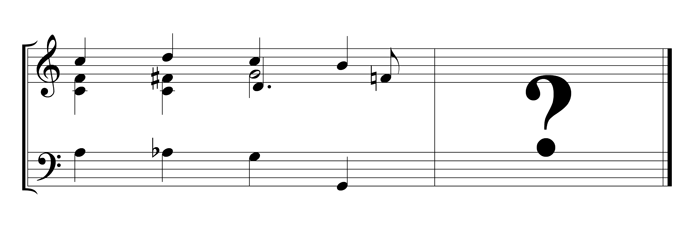Professional preparatory music theory: Basic elements of music theory.
Chapter 3 of the Basic elements of music theory – by Oscar van Dillen ©2014-16
The advanced learning book can be found at Outline of basic music theory.
Pages and chapters:
Chapter 1: Introduction
Chapter 2: Musical notation
Chapter 3: Building blocks of harmony – Scales
Chapter 4: Building blocks of harmony – Intervals
Chapter 5: Building blocks of harmony – Chords
Chapter 6: Keys and key signatures
Chapter 7: Further study
*section currently under construction*
Keys and key signatures
Music which has a functional harmonic center (the tonic) is called tonal music. Corresponding to, and harmonically resolving into the only two consonant triads, in music history just two types of keys have developed: major and minor keys.
Tonality
Tonality is perceived when a harmonic resolution can logically follow a moment of harmonic tension. In the example below harmonic tension is built up, how should it resolve:

example 35 – harmonic tension: what is the resolution?
- Acoustic tension is called dissonance, harmonic tension is called dominance;
- Acoustic tension is often used to emphasize harmonic tension but the two are musically different;
- Acoustic relaxation is called consonance, harmonic release or resolution is called tonicality;
- Acoustic relaxation may be used, but is not always necessary for harmonic release.
In the example below harmonic tension is built up again, and three different endings are proposed:

example 36 – harmonic tension and three different endings
Tonality always operates by the use of three harmonic functions, called tonic or T (home chord), dominant or D (moment of tension before going home) and subdominant or S (elsewhere, out). In the example above it is demonstrated how a progression from S to D creates a precise expectation of the T (including the expectation whether T should be major or minor in this case).
Keys
Every piece of music which is tonal, uses functional tonality and has a key, identified by its tonic and type, for example C major, F minor etc. Among other structuring principles of music, besides tonality, are modality (based on modes) and atonality (avoiding tonality).
All of the twelve chromatic tones can be a tonic to two different types of keys, so enharmonically there exist only 24 different keys. Key signatures which would make use of double alterations are not used, instead these would be enharmonized (e.g. Gb minor would be represented as F# minor, and G# major as Ab major etc.).
Key signatures
goto chapter 7 ► Further study
Oscar van Dillen ©2014-16
